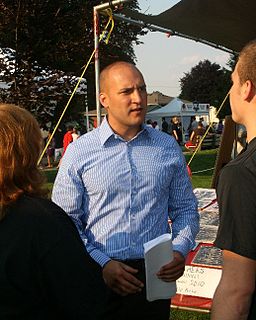
In California, a ballot proposition can be a referendum or an initiative measure that is submitted to the electorate for a direct decision or direct vote. If passed, it can alter one or more of the articles of the Constitution of California, one or more of the 29 California Codes, or another law in the California Statutes by clarifying current or adding statute(s) or removing current statute(s).
In the politics of the United States, the process of initiatives and referendums allow citizens of many U.S. states to place new legislation on a popular ballot, or to place legislation that has recently been passed by a legislature on a ballot for a popular vote. Initiatives and referendums, along with recall elections and popular primary elections, are signature reforms of the Progressive Era; they are written into several state constitutions, particularly in the West.
Robert F. Hagan is an American politician and member of the Democratic Party who held a seat in the Ohio House of Representatives for the Sixtieth District from 2007 to 2014. He represented the same seat from 1987 to 1997, and served in the Ohio Senate from 1997 to 2006.
Louis W. Blessing Jr. of Cincinnati, Ohio, is an American politician of the Republican party.

Elections in Oregon are all held using a Vote by Mail (VBM) system. This means that all registered voters receive their ballots via postal delivery and can vote from their homes. A state Voters’ Pamphlet is mailed to every household in Oregon about three weeks before each statewide election. It includes information about each measure and candidate in the upcoming election.
Shannon Jones is an American politician from the state of Ohio. A Republican, she was a member of the Ohio House of Representatives from 2007 to 2009 and a member of the Ohio Senate from 2009 to 2016. She is currently a county commissioner in Warren County, Ohio and the Executive Director of Groundwork Ohio.

Joseph L. Schiavoni is an American politician who formerly served as a member of the Ohio Senate and is a former Ohio Senate Minority Leader. On November 3, 2020, Schiavoni was elected to serve as a Judge in the Mahoning County Court System. Schiavoni is a Democrat.

The 2009 Washington Referendum 71 (R-71) legalized domestic partnership in Washington state, the first statewide referendum in the United States that extended to LGBT people the rights and responsibility of domestic partnership. The bill had passed State Legislature, and it was signed into law by the Governor in May 2009, but opponents gathered enough signatures to put the measure before the voters, who returned ballots by mail over three weeks ending on November 3, 2009, approving the measure 53% to 47%. The new law went into effect 30 days later, on December 3, 2009.

Armond D. Budish is an American politician currently serving in his second term as Cuyahoga County Executive. A member of the Democratic Party, he was a four-term Ohio State Representative, and served as Speaker of the House from 2009 to 2011. He was the first Jewish representative to hold that office. He was re-elected to the House in 2010 and 2012, and thereafter was term-limited.
Matt Huffman is a member of the Ohio Senate, representing the 12th district since 2017, and currently serving as the Ohio Senate Majority Leader as a Republican. The district includes Allen, Champaign, Mercer and Shelby counties, as well as parts of Auglaize, Darke and Logan counties.

The No Sales Tax for Alcohol Question, also known as Question 1, was on the November 2, 2010 ballot in Massachusetts. The measure asked voters whether to repeal a sales tax on alcohol sales. The ballot measure for the 2010 ballot was added after the Massachusetts State Legislature increased the sales tax in the state from 5% to 6.25% and eliminated an exemption for alcohol sold in liquor stores.

In February 2011, a series of public employee protests began in the United States against proposed legislation which would weaken the power of labor unions. By March, eighteen states had proposed legislation which would remove some collective bargaining powers from unions, along with another five states which proposed legislation which would negatively affect unions. The protests occurred when public employee unions mounted protests against legislation proposed by Republican governors such as Scott Walker (Wisconsin), Rick Scott (Florida), Mitch Daniels (Indiana), Sean Parnell (Alaska), Rick Snyder (Michigan), John Kasich (Ohio), Paul LePage (Maine) and Jan Brewer (Arizona) which, among other things, would strip public employees of some collective bargaining rights as well as require higher employee contributions to pension and health care plans. The governors stated they needed these changes in order to cut state spending and balance the states' budgets. The protests began in Wisconsin, then spread to Indiana and Ohio, with unions around the country rallying to show their opposition to the proposed legislation. Several other states considered similar legislation. Virginia, North Carolina, and Texas prohibit formal collective bargaining with public employees.

Maine Question 1 was a voter referendum conducted in Maine in 2009 that rejected a bill legalizing same-sex marriage in the state. The measure passed 53%–47% on November 3, 2009.
Fair, Accurate, Inclusive, and Respectful Education Act, also known as the FAIR Education Act and informally described by media outlets as the LGBT History Bill, is a California law which compels the inclusion of the political, economic, and social contributions of persons with disabilities and lesbian, gay, bisexual, and transgender people into educational textbooks and the social studies curricula in California public schools by amending the California Education Code. It also revises the previous designation of "black Americans, American Indians, Mexicans, Asians, [and] Pacific Island people" into a list considered Indigenous peoples of the Americas. It would also amend an existing law by adding sexual orientation and religion into a list of characteristics that schools are prohibited from sponsoring negative activities about or teaching students about in an adverse way.
Mike Duffey is an American politician who was appointed as Senior Vice Chancellor of the Ohio Department of Higher Education in January 2019. Duffey served as a member of the Ohio House of Representatives from 2011 to 2019.

Frank LaRose is an American politician. He is Ohio's secretary of state after serving two terms as a Republican member of the Ohio State Senate from Ohio's 27th Senate district which includes Wayne County as well as portions of Stark and Summit counties.

Maine Question 1 was a people's veto referendum that appeared on the June 12, 2018 statewide ballot. It sought to reject a law passed by the Maine Legislature that suspended the implementation of ranked choice voting, authorized by Maine voters in a previous referendum, for use in Maine elections until and if an amendment to the Maine Constitution is passed to expressly permit it; failing that, the law would be automatically repealed in 2021. It qualified because supporters of the original referendum collected the necessary number of signatures from registered Maine voters. This vote coincided with primary elections in which party nominees for governor, U.S. Senate, U.S. House, and the Maine Legislature were chosen through RCV to run in general elections on November 6.

Maine Question 1, "Do you want to reject the section of Chapter 399 of the Public Laws of 2011 that requires new voters to register to vote at least two business days prior to an election?", was a 2011 people's veto referendum that rejected a bill repealing Election Day voter registration in Maine. The vote was held on November 8, 2011 after being placed on the ballot due to supporters collecting the necessary number of signatures. The veto effort was successful, with 237,024 votes in favor of repeal to 155,156 against repeal.

California Proposition 6 was a measure that was submitted to California voters as part of the November 2018 election. The ballot measure proposed a repeal of the Road Repair and Accountability Act, which is also known as Senate Bill 1. The measure failed with about 57% of the voters against and 43% in favor.

Proposition 25, officially the Referendum to Overturn a 2018 Law That Replaced Money Bail System with A System Based on Public Safety Risk, is a California ballot proposition that appeared on the ballot for the general election on November 3, 2020. The "no" side prevailed, resulting in retention of the system of cash bail in the state.











